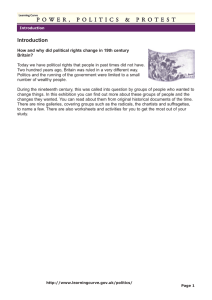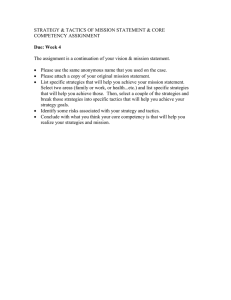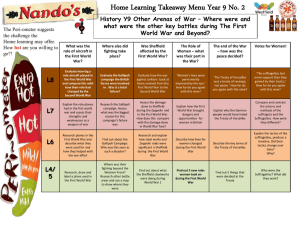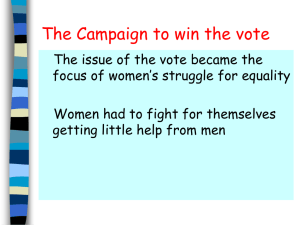es 2: comparing sources
advertisement
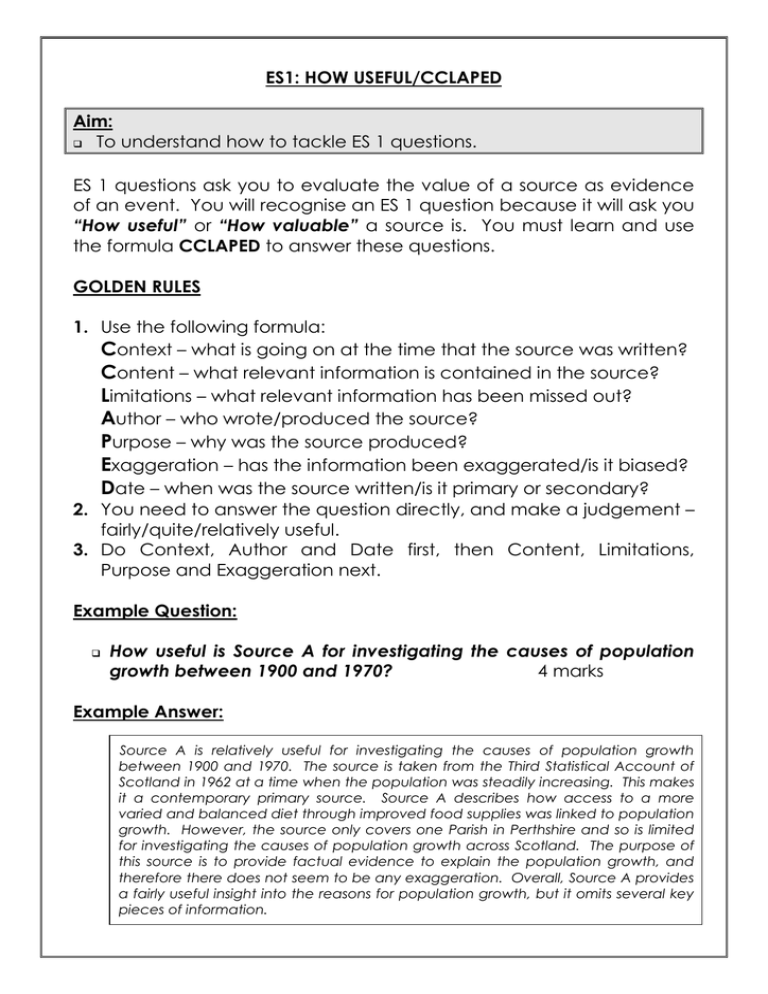
ES1: HOW USEFUL/CCLAPED Aim: To understand how to tackle ES 1 questions. ES 1 questions ask you to evaluate the value of a source as evidence of an event. You will recognise an ES 1 question because it will ask you “How useful” or “How valuable” a source is. You must learn and use the formula CCLAPED to answer these questions. GOLDEN RULES 1. Use the following formula: Context – what is going on at the time that the source was written? Content – what relevant information is contained in the source? Limitations – what relevant information has been missed out? Author – who wrote/produced the source? Purpose – why was the source produced? Exaggeration – has the information been exaggerated/is it biased? Date – when was the source written/is it primary or secondary? 2. You need to answer the question directly, and make a judgement – fairly/quite/relatively useful. 3. Do Context, Author and Date first, then Content, Limitations, Purpose and Exaggeration next. Example Question: How useful is Source A for investigating the causes of population growth between 1900 and 1970? 4 marks Example Answer: Source A is relatively useful for investigating the causes of population growth between 1900 and 1970. The source is taken from the Third Statistical Account of Scotland in 1962 at a time when the population was steadily increasing. This makes it a contemporary primary source. Source A describes how access to a more varied and balanced diet through improved food supplies was linked to population growth. However, the source only covers one Parish in Perthshire and so is limited for investigating the causes of population growth across Scotland. The purpose of this source is to provide factual evidence to explain the population growth, and therefore there does not seem to be any exaggeration. Overall, Source A provides a fairly useful insight into the reasons for population growth, but it omits several key pieces of information. ES 2: COMPARING SOURCES Aim: To understand how to tackle ES 2 questions. ES 2 questions ask you to compare the information contained in two historical sources. You will recognise an ES 2 question because it will ask you “How far” or “To what extent” sources agree or disagree about a historical event or development. You will only be asked ES 2 questions in Units II and III. GOLDEN RULES 1. You must identify: 1. Points of agreement. 2. Points of disagreement. 3. Points mentioned in only one source. 2. You must make 3 direct extended comparisons. Remember: “3 – it’s a magic number!” 3. You do not need any background knowledge. All the evidence comes from the sources. Example Question: How far do Sources A and B agree that Germany was a threat to Britain before 1914? 4 marks Example Answer: Sources A and B agree greatly that Germany was a threat to Britain in 1914. Both sources agree that the British were concerned about Germany as Source A mentions, “the worry among the British public” and Source B says, “Germany had always been disliked and distrusted.” Both sources agree that Germany posed a threat to Britain as Source A says Germany could “blockade our trade, defeat us at sea in be in London” and Source B says Germany “ has been suspected for years of looking forward to a war with Great Britain.” However, Source A states that Germany wanted to build a bigger fleet than that of Britain and this is not mentioned in Source B. ES 3: IDENTIFYING THE ATTITUDE CONTAINED IN A SOURCE Aim: To understand how to answer ES 3 questions. For ES 3 questions you have to be able to identify the viewpoint or attitude towards a historical event or development and then back it up with 3 pieces of evidence from the source. You will be able to identify an ES 3 question because it will ask you to identify the attitude of the source. You will only be asked ES 3 questions in Units II and III. GOLDEN RULES 1. You must identify whether the attitude is either positive, negative or mixed. 2. You must then identify three pieces of evidence from the source to support the attitude you have identified, but you need to explain them 3. You must use words like the author thinks, believes, feels… Don’t just state what he says (you will only get 1 mark for doing this!). Example Question: What was the attitude of the British public towards the growth of the German navy according to Source A? 4 marks Example Answer: According to Source A, the attitude of the British public towards the growth of the German navy is negative. The source suggests a feeling of fear, in saying that “The worry among the British public about Germany comes entirely from the question of German naval expenditure.” The source thinks that the British public are concerned about this because “Germany‟s intention is to build a fleet which is bigger than the British fleet.‟ The source believes that the British public are worried about the development because it meant that “She [Germany] would blockade our trade, defeat use at sea and be in London in a very short time with her army.” ES 4: PLACING THE SOURCE IN ITS WIDER HISTORICAL CONTEXT Aim: To understand how to answer ES 4 questions. For ES 4 questions you have to use your BACKGROUND KNOWLEDGE to show you have a wider knowledge of the topic introduced by the source. You will recognise an ES 4 question because it will ask you “How fully” a source explains a historical event or development. You will only be asked ES 4 questions in Units II and III. GOLDEN RULES 1. Your answer should always have two paragraphs and a very short conclusion. 2. Your first paragraph should mention 3 points from the source. 3. Your second paragraph should mention 3 points from your background knowledge, which are not mentioned in the source. 4. A very short concluding sentence will improve your answer. Example Question: How fully do Source A and B explain the worsening relations between Britain and Germany? You should use your own knowledge and give reasons for your answer. 5 marks Example answer: Sources A and B explain the worsening relations between Britain and Germany quite fully. Source A mentions that Britain is concerned by German naval expenditure because Germany wanted a fleet bigger than that of Britain. Source B mentions that Germany was suspected of looking forward to a war with Britain. However, the sources fail to mention several other reasons for the worsening relations. The sources do not mention that Germany was the leading member of the Triple Alliance and that Britain was a member of the Triple Entente with Germany‟s enemies, France and Russia. The sources fail to mention that Britain was threatened by the Kaiser‟s quest for a „place in the sun‟, especially in Morocco. In conclusion, the sources mention the naval arms race but not imperialism or alliances. ES 5: SELECTING EVIDENCE Aim: To understand how to answer ES 5 questions. ES 5 questions ask you to pick out pieces of evidence from several sources that support two different sides of an argument. For this type of question you need only to use the sources – no background knowledge is needed. You will recognise ES 5 questions because they are always in two parts, and they ask you “What evidence is there in the sources…” You will only be asked an ES 5 question in Unit I. GOLDEN RULES 1. Your answer can either take the form of two paragraphs, one looking at each part of the question/argument, or you can draw a table like the one below. 2. You need to find 3 quotes to support each side. 3. All the evidence comes from the sources. Example Question: What evidence is there in the sources to support the view that militant tactics damaged the cause of votes for women? What evidence is there in the sources to support the view that militant tactics did not damage the cause of votes for women? 6 marks Example Answer: Evidence to support the view that Evidence to support the view that militant tactics damaged the cause of militant tactics did not damage the votes for women cause of votes for women The Suffragettes were criticised for giving MPs an excuse to vote against the Conciliation Bill of 1912 (Source A) Government officials viewed women as “half-insane”(Source B) Most Dundonians called for severe punishment for fanatical females (Source C) The Suffragettes attracted a large following in Scotland (Source A) Suffragettes won admiration for their willingness to stand up for their beliefs (Source B) Their actions had resulted in many additional recruits (Source C) ES 6: BALANCED CONCLUSION Aim: To understand how to answer ES 6 questions. For ES 6 questions, you need to use the sources and recall in order to reach a balanced conclusion. You need an introduction, two paragraphs and a conclusion. You will recognise an ES 6 question, as they always follow an ES 5 question. The usually start with “How far do you agree that …” or “To what extent …” You will only be asked an ES 6 question in Unit I. GOLDEN RULES 1. Start by directly answering the question, then use the phrase “but there are two sides to the argument.” 2. You then need to look at both sides of the argument. You need 2 pieces of evidence from the sources and 1 piece of recall. 3. Use the phrases “On one hand…” and “On the other hand…” to start each paragraph. 4. Make a balanced conclusion based on the evidence presented. Example Question: How far do you agree that the militant tactics of the Suffragettes damaged the cause of votes for women? 5 marks Example Answer: I agree to some extent that the militant tactics of the suffragettes damaged the cause of votes for women, but there are two sides to the argument. There is much evidence to suggest that the militant tactics of the Suffragettes damaged the cause of votes for women. Source A states that the Suffragettes were criticised for giving the government an excuse to vote against the Conciliation Bill of 1912, while Source B states that government officials viewed the Suffragettes as „half-insane‟ because of their tactics. From recall, I know that many people viewed peaceful protest methods as more effective in helping the votes for women cause. On the other hand, is also evidence to show that militant tactics helped the votes for women cause. Source A states that the Suffragettes attracted a large following in Scotland. Source B describes how they won admiration for their willingness to stand up for their beliefs. From recall, I know that the militant actions of the Suffragettes attracted media attention to „the cause‟. In conclusion, the militant tactics of the Suffragettes did damage the cause of votes for women, but there is evidence to suggest that these tactics also had a positive impact on „the cause‟.
